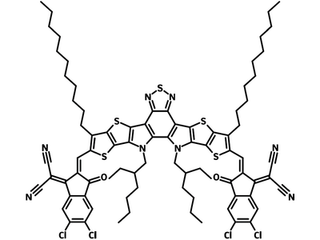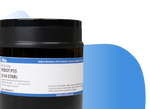High purity, low price Y7 (BTP-4Cl) non-fullerene acceptor
Achieve record breaking NFA organic photovoltaic solar cell power conversion efficiencies
Specifications | Pricing and Options | MSDS | Literature and Reviews
Y7 (CAS number 2414918-25-3), also known as BTP-4Cl, is the chlorinated version of Y6 (BTP-4F). It has an absorption range that extends to the near infrared (NIR) and has demonstrated a power conversion efficiency (PCE) up to 15.7% with PBDB-T-2F (PM6) as the polymer donor.
Like Y6, Y7 is a highly conjugated organic semiconductor and is composed of a fused thienothienopyrrolo-thienothienoindole (TTP-TTI) core base and 2-(5,6-dichloro-3-oxo-2,3-dihydro-1H-inden-1-ylidene)malononitrile (2ClIC) end units. Y7 has an A-DAD-A structure and is therefore electron deficient and hence suitable for use as a n-type non-fullerene electron acceptor (NFA) in OPV devices.
Compared to Y6, the chlorinated acceptor Y7 shows a redshift of about 20 nm in optical absorption and about 100 meV downshift in the LUMO level. Device film containing Y7 has a higher electroluminescence quantum efficiency (EQE = 3.47 × 10-4) than that of Y6 (1.40 × 10-4) with reduced non-radiative energy loss of ~ 24 meV. This reduced non-radiative energy loss yields a higher VOC of 0.867 V compared with that of the Y6 based device (0.834 V).
High efficient non-fullerene acceptor
with highly conjugated core
Expanded absorption range to near infrared
Large dipole moment induced by chloride substituents
Worldwide shipping
Quick and reliable shipping
High purity
>99% High purity
Record PCEs of 16.5% and 15.3% for OPV cells with 0.09 and 1 cm2 active areas were achieved when PBDB-T-2F (PM6) was used as the polymer donor and Y7 as the acceptor with the following device structure.
Device structure: ITO/ZnO/PM6:Y7/MoO3/Al.
| Thickness (nm) | VOC (V) | JSC (mA cm-2) | FF (%) | PCE (%) |
| 100 ± 4 | 0.867 | 25.4 | 75.0 | 16.5 (16.1 ± 0.2) |
Chemical Structure

General Information
| CAS Number | 2414918-25-3 |
| Chemical Formula | C82H86Cl4N8O2S5 |
| Purity | >99% (1H NMR) |
| Full Name | 2,2'-((2Z,2'Z)-((12,13-bis(2-ethylhexyl)-3,9-diundecyl-12,13-dihydro-[1,2,5]thiadiazolo[3,4-e]thieno[2",3’':4’,5']thieno[2',3':4,5]pyrrolo[3,2-g]thieno[2',3':4,5]thieno[3,2-b]indole-2,10-diyl)bis(methanylylidene))bis(5,6-dichloro-3-oxo-2,3-dihydro-1H-indene-2,1-diylidene))dimalononitrile |
| Molecular Weight | 1517.75 g/mol |
| HOMO / LUMO | HOMO = -5.65 eV, LUMO = -3.63 eV [1] |
| Form | Solid powder: Dark blue to black |
| Synonyms | BTP-4Cl, Y6Cl, TTPTTI-4Cl |
| Classification / Family | NFAs, n-type non-fullerene electron acceptors, Organic semiconducting materials, Low band-gap small molecule, Small molecular acceptor, Organic photovoltaics, Polymer solar cells, NF-PSCs. |
Pricing
| Batch | Quantity | Price |
| M2212A1 | 50 mg | £210 |
| M2212A1 | 100 mg | £330 |
| M2212A1 | 250 mg | £660 |
| M2212A1 | 500 mg | £1200 |
MSDS Documentation
Literature and Reviews
- Over 16% efficiency organic photovoltaic cells enabled by a chlorinated acceptor with increased open-circuit voltages, Y Cui et al., Nat. Commun., 10, 2515 (2019) doi: 10.1038/s41467-019-10351-5
- Single-Junction Organic Solar Cell with over 15% Efficiency Using Fused-Ring Acceptor with Electron-Deficient Core, J. Yuan et al., Joule (2019); doi: 10.1016/j.joule.2019.01.004.
- Achieving over 16% efficiency for single-junction organic solar cells, B. Fan et al., Sci. China Chem., 62, 6 746-752 (2019); doi: 10.1007/s11426-019-9457-5.
Related Products
Semiconducting polymers for bulk heterojunction, OPV, OLED, OFET and perovskite interfaces and solar cell research.

 BTP-4Cl MSDS Sheet
BTP-4Cl MSDS Sheet
